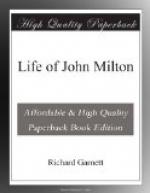As the girl-wife vanishes from Milton’s household her place is taken by the venerable figure of his father. The aged man had removed with his son Christopher to Reading, probably before August, 1641, when the birth of a child of his name—Christopher’s offspring as it should seem—appears in the Reading register. Christopher was to exemplify the law of reversion to a primitive type. Though not yet a Roman Catholic like his grandfather, he had retrograded into Royalism, without becoming on that account estranged from his elder brother. The surrender of Reading to the Parliamentary forces in April, 1643, involved his “dissettlement,” and the migration of his father to the house of John, with whom he was moreover better in accord in religion and politics. Little external change resulted, “the old gentleman,” says Phillips, “being wholly retired to his rest and devotion, with the least trouble imaginable.” About the same time the household received other additions in the shape of pupils, admitted, Phillips is careful to assure us, by way of favour, as M. Jourdain selected stuffs for his friends. Milton’s pamphlet was perhaps not yet published, or not generally known to be his, or his friends were indifferent to public sentiment. Opinion was unquestionably against Milton, nor can he have profited much by the support, however practical, of a certain Mrs. Attaway, who thought that “she, for her part, would look more into it, for she had an unsanctified husband, that did not walk in the way of Sion, nor speak the language of Canaan,” and by and by actually did what Milton only talked of doing. We have already seen that he had incurred danger of prosecution from the Stationers’ Company, and in July, 1644, he was denounced by name from the pulpit by a divine of much note, Herbert Palmer, author of a book long attributed to Bacon. But, if criticised, he was read. By 1645 his Divorce tract was in the third edition, and he had added three more pamphlets—one to prove that the revered Martin Bucer had agreed with him; two, the “Tetrachordon” and “Colasterion,” directed against his principal opponents, Palmer, Featley, Caryl, Prynne, and an anonymous pamphleteer, who seems to have been a somewhat contemptible person, a serving-man turned attorney, but whose production contains some not unwelcome hints on the personal aspects of Milton’s controversy. “We believe you count no woman to due conversation accessible, as to you, except she can speak Hebrew, Greek, Latin, and French, and dispute against the canon law as well as you.” Milton’s later tracts are not specially interesting, except for the reiteration of his fine and bold idealism on the institution of marriage, qualified only by his no less strenuous insistance on the subjection of woman. He allows, however, that “it is no small glory to man that a creature so like him should be made subject to him,” and that “particular exceptions may have place, if she exceed her husband in prudence and dexterity, and he contentedly yield; for then a superior and more natural law comes in, that the wiser should govern the less wise, whether male or female.”




